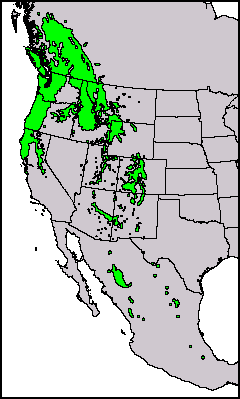Despite its common name, botanically, it is not a true
fir genus Abies.
Thus,
its common name is often hyphenated.
Not even a
🌲︎ pine genus Pinus,
spruce genus Picea,
hemlock genus Tsuga,
larch genus Larix,
nor even
arborvitae/cedar/cypress/incense cedar/juniper several genera.
Instead, …
Part of
genus Pseudotsuga
(meaning "false hemlock"), in
🌲︎ cedar / fir / hemlock / larch / pine / spruce family Pinaceae
in
🌲︎ conifer order Pinales.

Native to western North America:
• 🇨🇦 🇺🇸 Canada and USA coastal areas and mountains (P. menziesii var. menziesii),
• the 🗻︎ Rocky Mountains (P. menziesii var. glauca), and
• extending into Texas and 🇲🇽 México (probably in canyons) (P. menziesii var. lindleyana).
🗺 Map by county (🇺🇸 USA-48),
🗺 map (scroll down),
🗺 map (North America, Central America). 
Invasive > Hawai'i
🏛🌲︎ State tree of Oregon.
Uses by native peoples
(Ethnobotany database)
On No-Planting List by Seneca Nation of Indians SNI.  (pages 59 and 64)
(pages 59 and 64)
Pseudotsuga hosts caterpillars of 61 species
of butterflies and moths, in some areas.